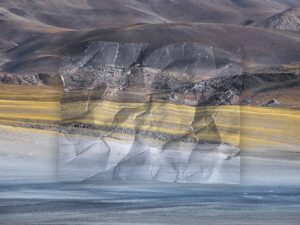Visibility is defined as “the state of being able to see or be seen.” It speaks to literal elements such as sight and perception, More broadly, however, it can relate to ideas of acknowledgement and representation. The concept is crucial, particularly within the art world, where it unearths themes of access, privilege and opportunity. A 2022 study conducted by Artnet News and Studio Burns found that, across 31 museums, 11% of acquisitions were works by female-identifying artists, and just 2.2% were by Black American artists. Now, Guggenheim Museum, New York, presents Going Dark: The Contemporary Figure at the Edge of Visibility, an exhibition that explores the desire to be seen and hidden from sight, all at once. 28 multigenerational, multiracial artists present over 100 pieces across painting, photography, print, installation, sculpture and video, spanning the mid-1980s to present day. The show, including work from Lorna Simpson, Ming Smith, as well as Farah Al Qasimi and Stephanie Syjuco, features partially obscured or hidden figures, observing ways in which different bodies are concealed in contemporary society.
Brooklyn-based photographer Farah Al Qasimi experiments with presence and absence using a distinct, playful style. In the artist’s series, It’s Not Easy Being Seen, smooth green fabric covers the faces of unknown figures. In one image, the sitter poses in pink headscarf, their hand wrapped around their face to frame themselves. In another, they are obscured behind a richly printed silk, spray-painted with the words, “Do you see it now?” The work follows the artist’s previous show, Poltergeist, which was on display at C/O Berlin this autumn. Here, Al Qasimi took inspiration from domestic-set horror movies of the 1970s and 1980s, resulting in an aesthetic that combined colour and humour. Her work asks how we frame the intangible, and how we split the difference between fiction and truth. The artist says: “I’m really aware of how conventions of good portraiture usually deal with somebody giving something of themselves up to the world.” What happens then when we strip back the image? Al Qasimi offers a powerful mode of image-making that speaks to topics of consumer-culture and femininity, asking what values we put on being seen.


In addition, Stephanie Syjuco works between archive excavations and more tactile forms. In Total Transparency Filter (Portrait of N) (2017), a seated figure is draped in a gray-and-white checkered cloth mirroring the default background of Photoshop. The depicted subject is a student in the federal Deferred Action for Childhood Arrivals (DACA) program. Through the work, Syjuco exposes the uncertain position of immigrants in the United States, at risk of deportation and total erasure. Elsewhere, in Block Out the Sun (2021), the artist interrogates colonial archives, exposing the racial prejudice that infiltrates visual culture. She draws attention to a faux Filipino village created for the 1904 World’s Fair — an international exhibition that celebrated American modernity — as she creates a counter-narrative to historical records. The artist explains: “A newly-acquired colony of the United States, Filipino culture was showcased for the American public via a living “human zoo,” filled with 1200 imported “natives” performing dances and rituals. These displays served dual purposes: as entertainment and as an ethnographic pedagogical tool for justifying racial hierarchy and white supremacy. After seeing image after image of this spectacle, it struck me that the photos, while historical, also serve to constantly reinscribe and reify the power dynamics of the time.” Syjuco uses her hands to redact the faces of Filipino individuals that were put on display. She intervenes, using her body to deflect any further fetishisation. It’s a kind of protest in the most physical sense, protecting the identity of men and women who were made vulnerable at the time.
Going Dark complicates the legibility of the image. It looks at the social and historic repercussions of how art has been used to entrap and simplify its subjects. More than this, however, it reclaims what it means to be visible, working against typical modes of perception. It urges audiences to engage more deeply, encouraging a greater awareness of who and what we prioritise, and thereby ignore, in turn.
Going Dark: The Contemporary Figure at the Edge of Visibility | Until 7 April 2024
Words: Chloe Elliott
Image Credits:
1. Lorna Simpson, Double Negative, 1990–2022. Gelatin silver print, 45 × 36 in.(114.3 × 91.4cm), edition 3/3.Courtesy the artist andHauser & Wirth.© Lorna Simpson, courtesy the artist and Hauser & Wirth. Photo: James Wang
2. Stephanie Syjuco, Total Transparency Filter (Portrait of N), 2017. Inkjet print,40 × 30 in. (101.6 × 76.2 cm).Courtesy the artist; RyanLee Gallery, New York; Catharine ClarkGallery, San Francisco; and Silverlens, Manila.© Stephanie Syjuco. Photo: Courtesy theartist;Ryan LeeGallery, New York; Catharine Clark Gallery, San Francisco; and Silverlens, Manila
3. Stephanie Syjuco, Block Out the Sun(Shadow), 2019-2022. Archival pigment print, 16 × 20 inches framed (40.6 × 50.8 cm). Courtesy the artist; Ryan Lee Gallery, NewYork; Catharine Clark Gallery, San Francisco; and Silverlens, Manila. © Stephanie Syjuco.Photo: Courtesy the artist; Ryan Lee Gallery,New York; Catharine Clark Gallery, SanFrancisco; and Silverlens, Manila





